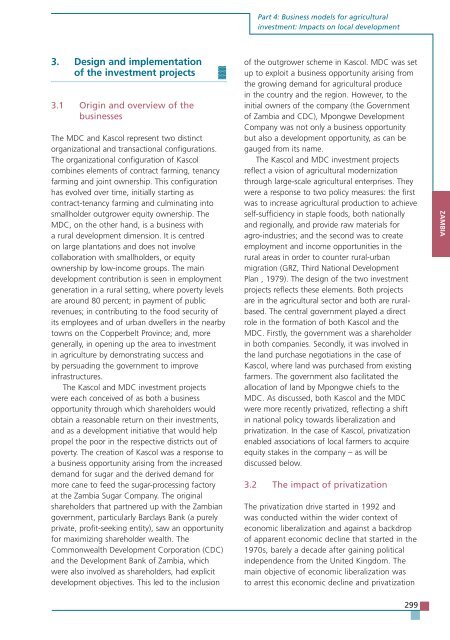TRENDS AND IMPACTS OF FOREIGN INVESTMENT IN DEVELOPING COUNTRY AGRICULTURE
TRENDS AND IMPACTS OF FOREIGN INVESTMENT IN DEVELOPING COUNTRY AGRICULTURE
TRENDS AND IMPACTS OF FOREIGN INVESTMENT IN DEVELOPING COUNTRY AGRICULTURE
Create successful ePaper yourself
Turn your PDF publications into a flip-book with our unique Google optimized e-Paper software.
3. Design and implementation<br />
of the investment projects <br />
3.1 Origin and overview of the<br />
businesses<br />
The MDC and Kascol represent two distinct<br />
organizational and transactional configurations.<br />
The organizational configuration of Kascol<br />
combines elements of contract farming, tenancy<br />
farming and joint ownership. This configuration<br />
has evolved over time, initially starting as<br />
contract-tenancy farming and culminating into<br />
smallholder outgrower equity ownership. The<br />
MDC, on the other hand, is a business with<br />
a rural development dimension. It is centred<br />
on large plantations and does not involve<br />
collaboration with smallholders, or equity<br />
ownership by low-income groups. The main<br />
development contribution is seen in employment<br />
generation in a rural setting, where poverty levels<br />
are around 80 percent; in payment of public<br />
revenues; in contributing to the food security of<br />
its employees and of urban dwellers in the nearby<br />
towns on the Copperbelt Province; and, more<br />
generally, in opening up the area to investment<br />
in agriculture by demonstrating success and<br />
by persuading the government to improve<br />
infrastructures.<br />
The Kascol and MDC investment projects<br />
were each conceived of as both a business<br />
opportunity through which shareholders would<br />
obtain a reasonable return on their investments,<br />
and as a development initiative that would help<br />
propel the poor in the respective districts out of<br />
poverty. The creation of Kascol was a response to<br />
a business opportunity arising from the increased<br />
demand for sugar and the derived demand for<br />
more cane to feed the sugar-processing factory<br />
at the Zambia Sugar Company. The original<br />
shareholders that partnered up with the Zambian<br />
government, particularly Barclays Bank (a purely<br />
private, profit-seeking entity), saw an opportunity<br />
for maximizing shareholder wealth. The<br />
Commonwealth Development Corporation (CDC)<br />
and the Development Bank of Zambia, which<br />
were also involved as shareholders, had explicit<br />
development objectives. This led to the inclusion<br />
Part 4: Business models for agricultural<br />
investment: Impacts on local development<br />
of the outgrower scheme in Kascol. MDC was set<br />
up to exploit a business opportunity arising from<br />
the growing demand for agricultural produce<br />
in the country and the region. However, to the<br />
initial owners of the company (the Government<br />
of Zambia and CDC), Mpongwe Development<br />
Company was not only a business opportunity<br />
but also a development opportunity, as can be<br />
gauged from its name.<br />
The Kascol and MDC investment projects<br />
reflect a vision of agricultural modernization<br />
through large-scale agricultural enterprises. They<br />
were a response to two policy measures: the first<br />
was to increase agricultural production to achieve<br />
self-sufficiency in staple foods, both nationally<br />
and regionally, and provide raw materials for<br />
agro-industries; and the second was to create<br />
employment and income opportunities in the<br />
rural areas in order to counter rural-urban<br />
migration (GRZ, Third National Development<br />
Plan , 1979). The design of the two investment<br />
projects reflects these elements. Both projects<br />
are in the agricultural sector and both are ruralbased.<br />
The central government played a direct<br />
role in the formation of both Kascol and the<br />
MDC. Firstly, the government was a shareholder<br />
in both companies. Secondly, it was involved in<br />
the land purchase negotiations in the case of<br />
Kascol, where land was purchased from existing<br />
farmers. The government also facilitated the<br />
allocation of land by Mpongwe chiefs to the<br />
MDC. As discussed, both Kascol and the MDC<br />
were more recently privatized, reflecting a shift<br />
in national policy towards liberalization and<br />
privatization. In the case of Kascol, privatization<br />
enabled associations of local farmers to acquire<br />
equity stakes in the company – as will be<br />
discussed below.<br />
3.2 The impact of privatization<br />
The privatization drive started in 1992 and<br />
was conducted within the wider context of<br />
economic liberalization and against a backdrop<br />
of apparent economic decline that started in the<br />
1970s, barely a decade after gaining political<br />
independence from the United Kingdom. The<br />
main objective of economic liberalization was<br />
to arrest this economic decline and privatization<br />
299<br />
ZAMBIA


